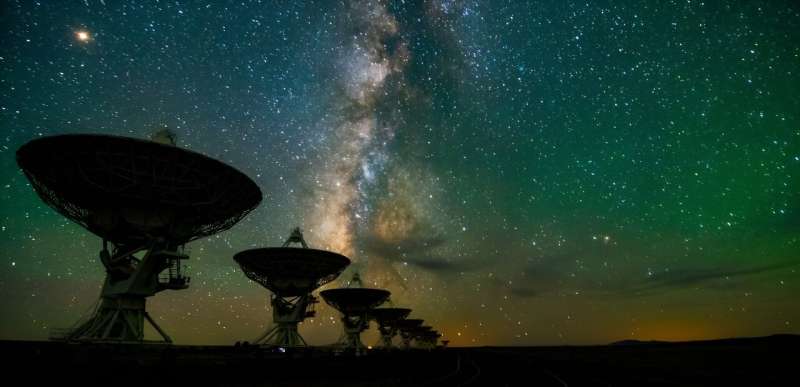This article has been reviewed according to Science X's editorial process and policies. Editors have highlighted the following attributes while ensuring the content's credibility:
fact-checked
preprint
trusted source
proofread
Do advanced civilizations know we're here?

Adrift in a great sea of stars, we must surely not be alone.
It's hard not to look at the night sky and think about the possibility of other civilizations out there. From the philosophical speculations of Giordano Bruno to the statistical estimations of Frank Drake, the more we've learned about the universe, the more likely alien life seems to be. And yet, in our search for this life, we have heard nothing but silence.
It's always possible that we are the only living things in the cosmos, just as it is possible other civilizations keep to themselves or use communication technology invisible to us. But radio communication is both powerful and cheap, and we use it extensively. Our radio signals have been beaming from Earth for decades. So why shouldn't other civilizations use radio as well?
There are some who feel we're being too optimistic. Although we do emit plenty of radio signals into space, the power of radio light fades with distance as it fills an ever-expanding sphere. Combined with interference from the dust and gas of interstellar space, it is likely our signals could only be heard within a few light years of Earth using radio receivers we currently have today. We have directly transmitted powerful radio messages into space a few times, such as the Arecibo message beamed to the Hercules cluster in 1974. But even these would be terribly faint by the time they travel 22,000 light-years to their destination.
Of course, we are a young and simple species. Perhaps an ancient, hyper-advanced species could pull our messages out of the cosmic dust. But could they do it across hundreds or thousands of light-years? That's the question examined in a new paper published on the arXiv preprint server.

The author starts with the Kardashev scale for advanced civilizations. First proposed in 1964, the scale ranks civilizations based on their ability to tap energy resources. A Type I civilization can access energy on a planetary scale, Type II on the scale of a star system, and Type III on a galactic scale. Carl Sagan and others have generalized this to a sliding scale and estimated humans are around 0.73. Based on this, the author asks what scale a civilization needs to be in order to detect relics of human civilization, and what distance would this be possible?
Given that our artificial radio signals only penetrate a hundred light-years of space, a species would have a better chance of trying to resolve artificial features on Earth. Things on the scale of cities or major earthworks. As an example, consider the pyramids of Giza. They have been around for thousands of years, and the Great Pyramid has a base of about 230 meters.
Given the amount of light reaching the Earth, the pyramids wouldn't be visible beyond a few thousand light years or so, regardless of the power of your telescope. Not enough photons would reach beyond that distance to resolve anything. Taking the middle range of visible light (about 550nm) and a resolution of 10 meters, the maximum distance comes out to about 3,000 light-years.
To resolve pyramid-scale features at this distance you would need an optical telescope with a diameter of about 10 AU. That's a bit larger than the orbit of Saturn. A telescope on that scale could in principle be constructed using an optical telescope array with millions of satellites across Saturn's orbit. Of course, this is far beyond our current ability, or that of any planet-scale civilization. You would at least need to be masters of your star system.
So the upshot of all this is that a Type II civilization could see our great works of humanity within 3,000 light years. A great alien species might know that we're here after all. But it will be thousands of years before we reach level 2 and are able to see them in return.
More information: Z. N. Osmanov, Are we visible to advanced alien civilizations?, arXiv (2023). DOI: 10.48550/arxiv.2308.08689
Journal information: arXiv
Provided by Universe Today




















